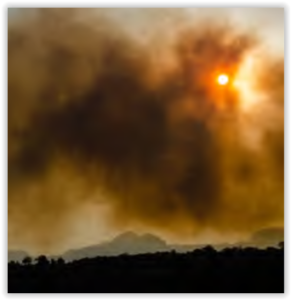Where There’s Smoke …
CAN WILDFIRES IMPACT INDOOR AIR QUALITY?
 In Texas, wildfire season reaches its peak in early fall, after months of hot weather dry up the land. Large portions of the state become like a box of kindling, and a single spark can set off acres of raging fire. While the images of burning flames can be terrifying, sometimes the biggest threat from wildfires isn’t the fire itself; it’s the smoke.
In Texas, wildfire season reaches its peak in early fall, after months of hot weather dry up the land. Large portions of the state become like a box of kindling, and a single spark can set off acres of raging fire. While the images of burning flames can be terrifying, sometimes the biggest threat from wildfires isn’t the fire itself; it’s the smoke.
Smoke is made up of complex particles, including semivolatile and volatile organic compounds (VOCs), polynuclear aromatic hydrocarbons (PAHs), particulate matter (PM), and organic acids. Many of these compounds pose long-term and short-term dangers to a person’s health and can cause serious property damage. During wildfires, more areas are evacuated due to the risk of smoke than the chance of fire. While the fire may be many miles away, smoke can travel a great distance, literally as fast as the wind blows.
Even if all the doors and windows are shut tight, smoke and soot from wildfires can get inside a building. Smoke is made up of “ultrafine particles,” which are only 0.15–0.4 inches in diameter. These particles are too small to be removed by standard air filters. As many commercial buildings draw air from the outside, smoke particles can easily pass into a building. Even if smoke is unable to enter your building during a fire, air currents and foot traffic can bring in ash and soot after the flames have been extinguished.
Soot can easily stain carpet, drapes, and other items throughout a building. The sharp odor from smoke may also permeate furniture and walls, lingering there for years. These effects are not just aesthetically unpleasant; they can potentially trigger health problems in building occupants. If fires have been a problem in your area, put the IAQ of your building high on your priority list. Structural damage isn’t the only threat fires and smoke can pose to a building. Contact an indoor air quality consultant to make sure your building is safe to occupy.
